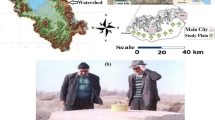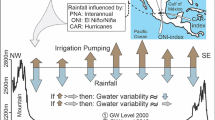Abstract
In recent decades, increasing global water demand, coupled with the effects of climate change, has led to increased variation in groundwater level depletion. In this work, the effect of climate parameters is investigated with respect to groundwater levels in the Shabestar Plain, Iran. In the first step, the best models for the study region were selected from the general circulation models provided under the Fifth Assessment Report of the United Nations Intergovernmental Panel on Climate Change. To increase the spatial resolution of the precipitation data, downscaling of the models was performed using the Long Ashton Research Station weather generator for three representative concentration pathway (RCP) scenarios (RCP2.6, RCP4.5, RCP8.5) for the future period 2020–2049. The results of these models illustrated an increase in temperature and a decrease in precipitation for the study region. In the next step, an artificial neural network (ANN) technique for studying aquifer behavior was used. To increase the efficiency of the model, spatial and temporal preprocessing of data was performed using k-means clustering and wavelet transform de-noising, respectively. A fuzzy inference system was also used as a tool for estimating groundwater extraction and reducing uncertainty of illegal extraction. The results of ANN for five selected observation wells showed correlation coefficients of 0.92, 0.86, 0.76, 0.57 and 0.94 for the simulation. The model simulation under the three above-mentioned scenarios and the trend in groundwater decline in the Shabestar Plain for the base and future periods illustrated that the groundwater level dynamics were not related solely to climate parameters and that the impact of anthropogenic factors would be high.
Similar content being viewed by others
References
Asghari MA, Mohammadi A (2003) Sources of salinity in groundwater of Shabestar plain aquifers. J Agric Sci (Univ Tabriz) 13(3):69–78
Banerjee P, Singh V, Chatttopadhyay K, Chandra P, Singh B (2011) Artificial neural network model as a potential alternative for groundwater salinity forecasting. J Hydrol 398(3):212–220
Barzegar R, Moghaddam AA, Soltani S, Fijani E, Tziritis E, Kazemian N (2017) Heavy metal(loid)s in the groundwater of Shabestar area (Nw Iran): source identification and health risk assessment. Expo Health. https://doi.org/10.1007/s12403-017-0267-5
Bashi-Azghadi SN, Kerachian R, Bazargan-Lari MR, Solouki K (2010) Characterizing an unknown pollution source in groundwater resources systems using PSVM and PNN. Expert Syst Appl 37(10):7154–7161
Bear J, Cheng AHD (2010) Modeling groundwater flow and contaminant transport. Springer, New York
Cannas B, Fanni A, See L, Sias G (2006) Data preprocessing for river flow forecasting using neural networks: wavelet transforms and data partitioning. Phys Chem Earth Parts A/B/C 31(18):1164–1171
Chang J, Wang G, Mao T (2015) Simulation and prediction of suprapermafrost groundwater level variation in response to climate change using a neural network model. J Hydrol 529:1211–1220
Chang F-J, Chang L-C, Huang C-W, Kao I-F (2016) Prediction of monthly regional groundwater levels through hybrid soft-computing techniques. J Hydrol 541:965–976
Chaudhari S, Felfelani F, Shin S, Pokhrel Y (2018) Climate and anthropogenic contributions to the desiccation of the second largest saline lake in the twentieth century. J Hydrol 560:342–353
Choubin B, Malekian A (2017) Combined gamma and M-test-based ANN and ARIMA models for groundwater fluctuation forecasting in semiarid regions. Environ Earth Sci 76(15):538
Coulibaly P, Anctil F, Aravena R, Bobee B (2001) Artificial neural network modeling of water table depth fluctuations. Water Resour Res 37(4):885–896
Daliakopoulos IN, Coulibaly P, Tsanis IK (2005) Groundwater level forecasting using artificial neural networks. J Hydrol 309(1–4):229–240
De Graaf IEM (2016) Limits to global groundwater consumption: effects on groundwater levels and river low flows. Utrecht University, Utrecht. ISBN 978-90-6266-418-4
Ebrahimi H, Rajaee T (2017) Simulation of groundwater level variations using wavelet combined with neural network, linear regression and support vector machine. Glob Planet Change 148:181–191
Eslamian S (2014) Handbook of engineering hydrology: vol 2: modeling, climate change, and variability. CRC Press, Boca Raton
Foddis ML, Ackerer P, Montisci A, Uras G (2013) Polluted aquifer inverse problem solution using artificial neural networks. AQUA Mundi 4:15–21
Foddis ML, Ackerer P, Montisci A, Uras G (2015) ANN-based approach for the estimation of aquifer pollutant source behaviour. Water Sci Technol Water Supply 15(6):1285–1294
Ghose DK, Panda SS, Swain PC (2010) Prediction of water table depth in western region, Orissa using BPNN and RBFN neural networks. J Hydrol 394(3–4):296–304
Green TR, Taniguchi M, Kooi H, Gurdak JJ, Allen DM, Hiscock KM, Treidel H, Aureli A (2011) Beneath the surface of global change: impacts of climate change on groundwater. J Hydrol 405(3):532–560
IPCC (2014) Fifth assessment report (AR5): Climate change 2013: 2014/climate change 2014: impacts, adaptation, and vulnerability; Part B. Cambridge University Press, Cambridge
Kabiri R (2014) Assessment of climate change impact on runoff and peak flow: a case study on Klang watershed in West Malaysia. University of Nottingham, Nottingham
Li Z, Mao X-Z (2011) Global multiquadric collocation method for groundwater contaminant source identification. Environ Modell Softw 26(12):1611–1621
Li X, Tsai FTC (2009) Bayesian model averaging for groundwater head prediction and uncertainty analysis using multimodel and multimethod. Water Resour Res 45(9):W09403
Mamdani EH, Assilian S (1975) An experiment in linguistic synthesis with a fuzzy logic controller. Int J Man Mach Stud 7(1):1–13
McCallum J, Crosbie R, Walker G, Dawes W (2010) Impacts of climate change on groundwater in Australia: a sensitivity analysis of recharge. Hydrogeol J 18(7):1625–1638
McCuen RH (2016) Modeling hydrologic change: statistical methods. CRC Press, Boca Raton
Mohamed A, Hawas Y (2004) Neuro-fuzzy logic model for evaluating water content of sandy soils. Comput Aided Civ Infrastruct Eng 19(4):274–287
Nason GP, Von Sachs R (1999) Wavelets in time-series analysis. Philos Trans R Soc Lond A Math Phys Eng Sci 357(1760):2511–2526
Nourani V (2015) Basics of hydroinformatics, in Farsi. Tabriz University Press, Tabriz
Nourani V, Andalib G (2015) Daily and monthly suspended sediment load predictions using wavelet based artificial intelligence approaches. J Mt Sci 12(1):85–100
Nourani V, Mousavi S (2016) Spatiotemporal groundwater level modeling using hybrid artificial intelligence-meshless method. J Hydrol 536:10–25
Nourani V, Mogaddam AA, Nadiri AO (2008) An ANN-based model for spatiotemporal groundwater level forecasting. Hydrol Process 22(26):5054–5066
Nourani V, Komasi M, Mano A (2009) A multivariate ANN-wavelet approach for rainfall–runoff modeling. Water Resour Manag 23(14):2877
Nourani V, Baghanam AH, Rahimi AY, Nejad FH (2014) Evaluation of wavelet-based de-noising approach in hydrological models linked to artificial neural networks. Comput Intell Tech Earth Environ Sci. https://doi.org/10.1007/978-94-017-8642-3_12
Nourani V, Alami MT, Vousoughi FD (2015) Wavelet-entropy data pre-processing approach for ANN-based groundwater level modeling. J Hydrol 524:255–269
Nourani V, Mousavi S, Dabrowska D, Sadikoglu F (2017) Conjunction of radial basis function interpolator and artificial intelligence models for time-space modeling of contaminant transport in porous media. J Hydrol 548:569–587
Rajaee T, Nourani V, Pouraslan F (2016) Groundwater level forecasting using wavelet and kriging. J Hydraul Struct 2(2):1–21
Shiri J, Kisi O, Yoon H, Lee K-K, Nazemi AH (2013) Predicting groundwater level fluctuations with meteorological effect implications A comparative study among soft computing techniques. Comput Geosci 56:32–44
Singh RM, Datta B (2007) Artificial neural network modeling for identification of unknown pollution sources in groundwater with partially missing concentration observation data. Water Resour Manag 21(3):557–572
Singh RM, Datta B, Jain A (2004) Identification of unknown groundwater pollution sources using artificial neural networks. J Water Resour Plan Manag 130(6):506–514
Sreekanth P, Sreedevi P, Ahmed S, Geethanjali N (2011) Comparison of FFNN and ANFIS models for estimating groundwater level. Environ Earth Sci 62(6):1301–1310
Takagi T, Sugeno M (1985) Fuzzy identification of systems and its applications to modeling and control. IEEE Trans Syst Man Cybern 1:116–132
Taormina R, Chau K-W (2015) Neural network river forecasting with multi-objective fully informed particle swarm optimization. J Hydroinform 17(1):99–113
Tapoglou E, Karatzas GP, Trichakis IC, Varouchakis EA (2014) A spatio-temporal hybrid neural network-Kriging model for groundwater level simulation. J Hydrol 519:3193–3203
Treidel H, Martin-Bordes JL, Gurdak JJ (2011) Climate change effects on groundwater resources: a global synthesis of findings and recommendations. CRC Press, Boca Raton
Wada Y (2013) Human and climate impacts on global water resources. Utrecht University, Utrecht. ISBN 978-90-6266-346-0
Yoon H, Jun S-C, Hyun Y, Bae G-O, Lee K-K (2011) A comparative study of artificial neural networks and support vector machines for predicting groundwater levels in a coastal aquifer. J Hydrol 396(1–2):128–138
Zamanirad M, Sedghi H, Sarraf A, Saremi A, Rezaee P (2018) Potential impacts of climate change on groundwater levels on the Kerdi-Shirazi plain, Iran. Environ Earth Sci 77(11):415
Acknowledgements
The authors extend their deepest thanks to the East Azerbaijan Regional Water Organization and Meteorological Organization for their contributions as well as preparation of data used in this research.
Author information
Authors and Affiliations
Corresponding author
Additional information
Publisher's Note
Springer Nature remains neutral with regard to jurisdictional claims in published maps and institutional affiliations.
Electronic supplementary material
Below is the link to the electronic supplementary material.
Rights and permissions
About this article
Cite this article
Jeihouni, E., Eslamian, S., Mohammadi, M. et al. Simulation of groundwater level fluctuations in response to main climate parameters using a wavelet–ANN hybrid technique for the Shabestar Plain, Iran. Environ Earth Sci 78, 293 (2019). https://doi.org/10.1007/s12665-019-8283-3
Received:
Accepted:
Published:
DOI: https://doi.org/10.1007/s12665-019-8283-3












